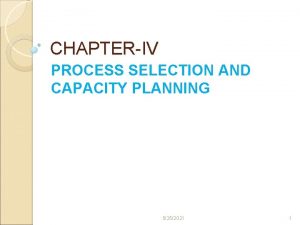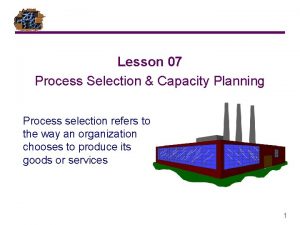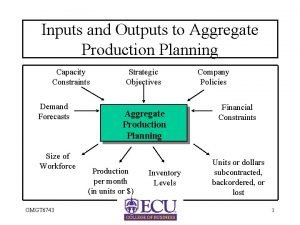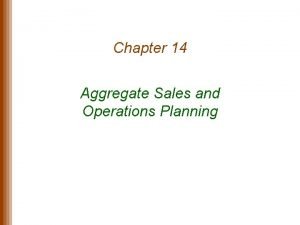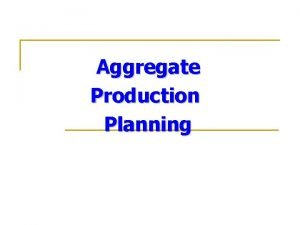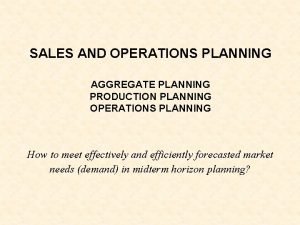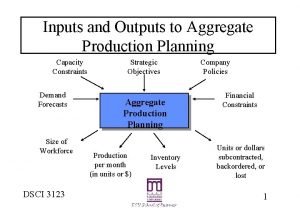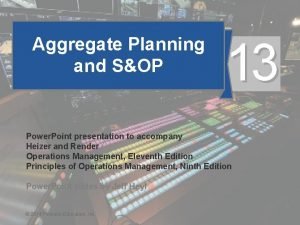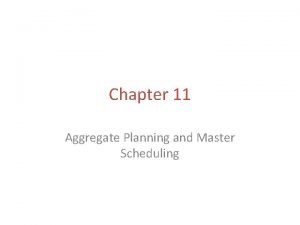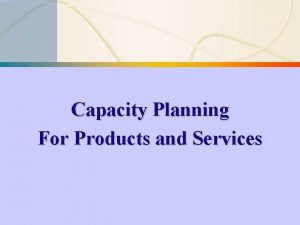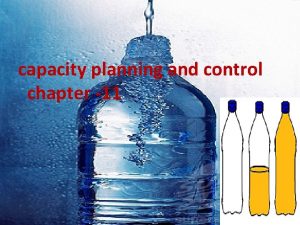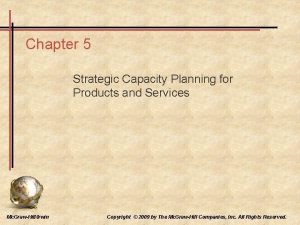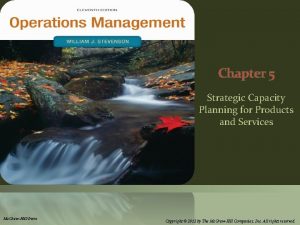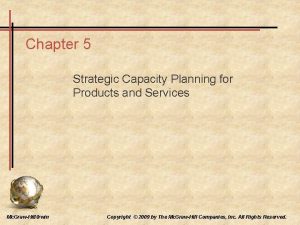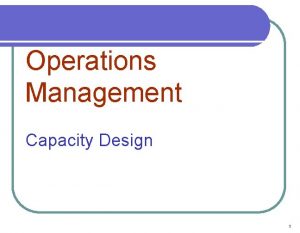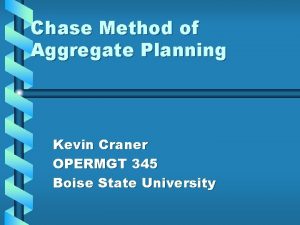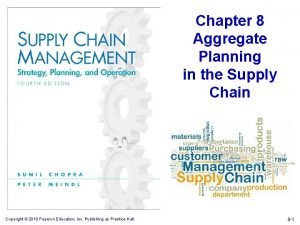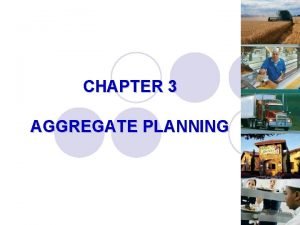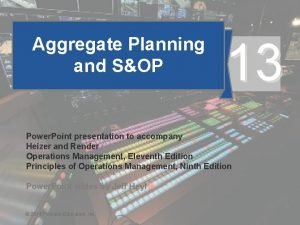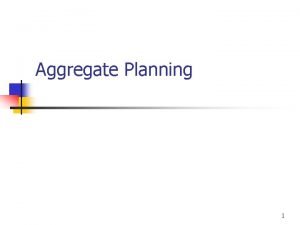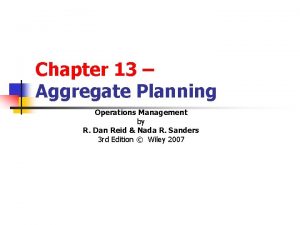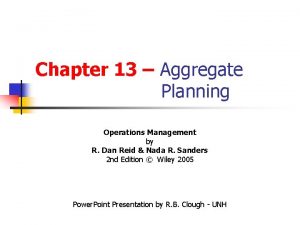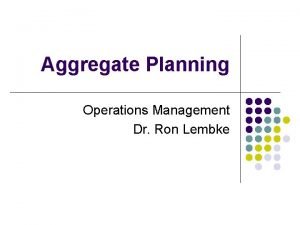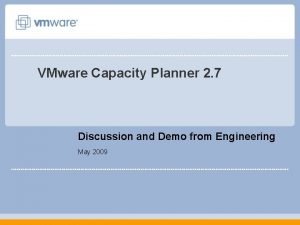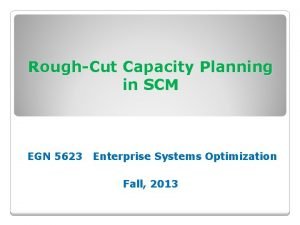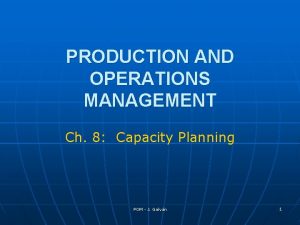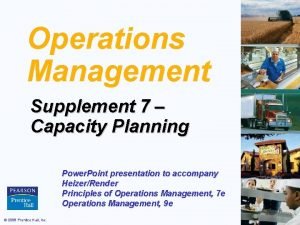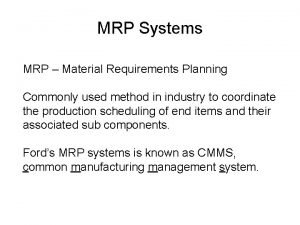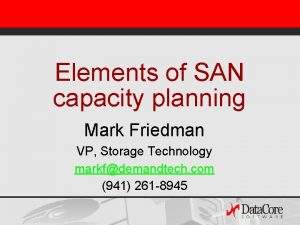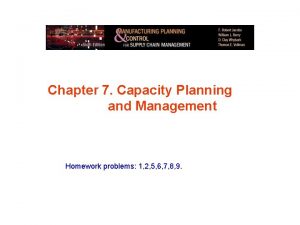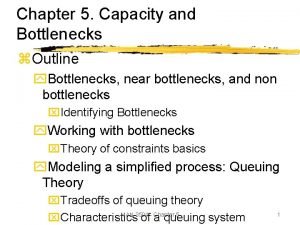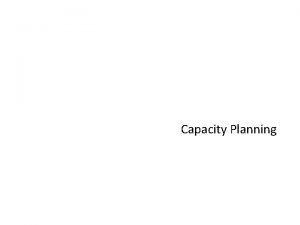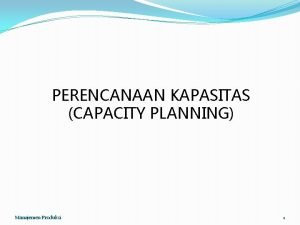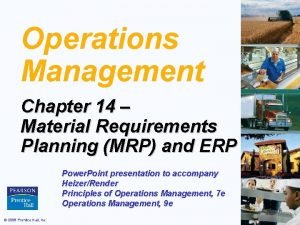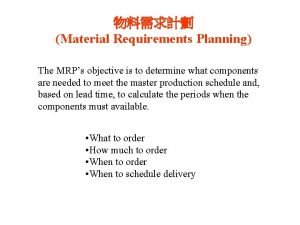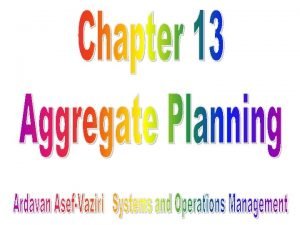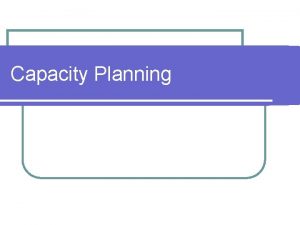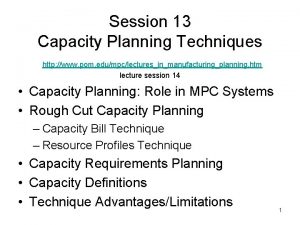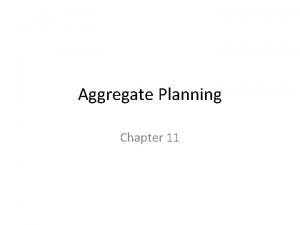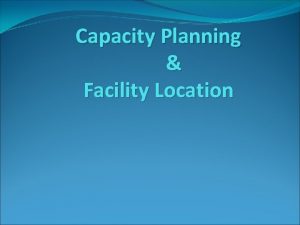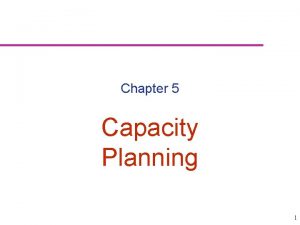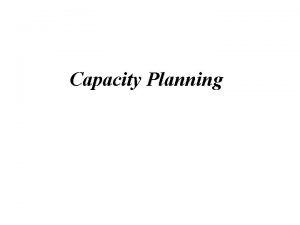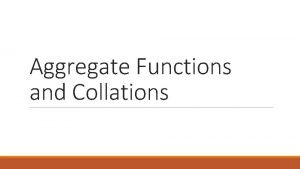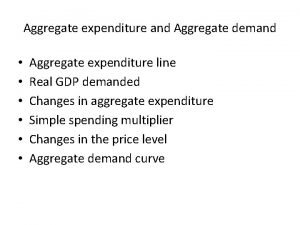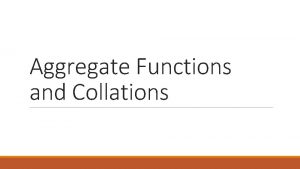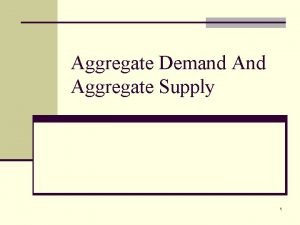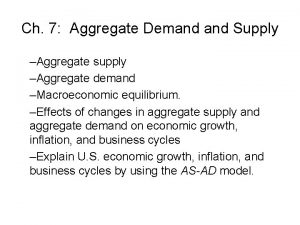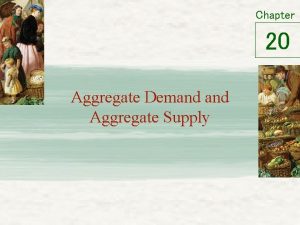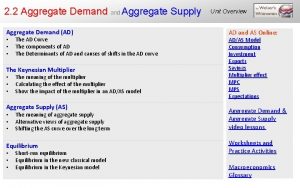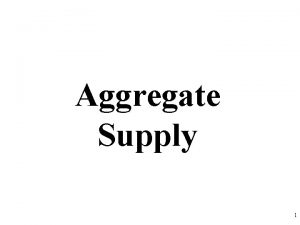Capacity and Aggregate Planning Aggregate Planning The process


























































- Slides: 58

Capacity and Aggregate Planning

Aggregate Planning • The process of planning the quantity and timing of output over the intermediate range (3 -18 months) by adjusting production rate, employment, inventory • Master Production Schedule: formalizes the production plan and translates it into specific end item requirements over the short to intermediate horizon

Capacity Planning • The process of determining the amount of capacity required to produce in the future. May be at the aggregate or product line level • Master Production Schedule anticipated build schedule • Time horizon must exceed lead times for materials

Capacity Planning • Look at lead times, queue times, set up times, run times, wait times, move times • Resource availability • Material and capacity - should be in synch • driven by dispatch list - listing of manufacturing orders in priority sequence - ties to layout planning • load profiles - capacity of each section

Capacity Planning • Rough Cut Capacity Planning process of converting the master production schedule into requirements for key resources • capacity requirements plan - timephased display of present and future capacity required on all resources based on planned and released orders

Capacity Planning • Capacity Requirements Planning (CRP) - process of determining in detail the amount of labor and machine resources required to meet production plan • RCCP may indicate sufficient capacity but the CRP may indicate insufficient capacity during specific time periods

Theory of Constraints • Every system has a bottle neck • capacity of the system is constrained by the capacity of the bottle neck • increasing capacity at other than bottle neck operations does not increase the overall capacity of the system • inertia of change can create new bottle necks

Capacity Planning ü Establishes overall level of productive resources ü Affects lead time responsiveness, cost & competitiveness ü Determines when and how much to increase capacity

Capacity Expansion ü Volume & certainty of anticipated demand ü Strategic objectives for growth ü Costs of expansion & operation ü Incremental or one-step expansion

Capacity Expansion Strategies (a) Capacity lead strategy (b) Capacity lag strategy Capacity Demand Units Demand Capacity Time (c) Average capacity strategy Time (d) Incremental vs. one-step expansion One-step expansion Capacity Units Demand Incremental expansion Demand Figure 9. 1 Time

Lead • Advantages • anticipates demand • first to market • lure from competitors • Disadvantages • product problems • product acceptability • consumers unfamiliar with product • R&D costs

Lag • Advantages • established demand for product • less R&D • growth market • Follower strategy • when to enter market - downside if too late in life cycle • loss of customers to first to market Assumes customers lost to Lead strategy will return - Western Sizzlin’

Average Capacity • • Advantages level production stable work force excess capacity potential • Chasing half the time • market timing • excess product

Aggregate Production Planning (APP) ü Matches market demand to company resources ü Plans production 6 months to 12 months in advance ü Expresses demand, resources, and capacity in general terms ü Develops a strategy for economically meeting demand ü Establishes a company-wide game plan for allocating resources ü also called Sales and Operations Planning

Sales and Operations Planning (S&OP) • Brings together all plans for business • performed at least once a month

Inputs and Outputs to APP Capacity Constraints Demand Forecasts Size of Workforce Figure 9. 3 Strategic Objectives Aggregate Production Planning Production per month (in units or $) Inventory Levels Company Policies Financial Constraints Units or dollars subcontracted, backordered, or lost

Adjusting Capacity to Meet Demand 1. Producing at a constant rate and using inventory to absorb fluctuations in demand (level production) 2. Hiring and firing workers to match demand (chase demand) 3. Maintaining resources for high demand levels 4. Increase or decrease working hours (overtime and undertime) 5. Subcontracting work to other firms 6. Using part-time workers 7. Providing the service or product at a later time period (backordering)

Strategy Details ü Level production - produce at constant rate & use inventory as needed to meet demand ü Chase demand - change workforce levels so that production matches demand ü Maintaining resources for high demand levels - ensures high levels of customer service

Strategy Details ü Overtime & undertime - common when demand fluctuations are not extreme ü Subcontracting - useful if supplier meets quality & time requirements ü Part-time workers - feasible for unskilled jobs or if labor pool exists ü Backordering - only works if customer is willing to wait for product/services

Level Production Demand Units Production Time Figure 9. 4 (a)

Level Production • Advantages • stable work force • no overtime or additional hiring costs • • • Disadvantages inventory obsolescence carrying costs depends on real good forecasts

Chase Demand Units Production Time Figure 9. 4 (b)

Chase Strategy • Advantages • less inventory • less chance for obsolete merchandise • Disadvantages • Never a stable production level • work force instability • hiring/firing costs • always a priority

Demand Management ü Shift demand into other periods ü Incentives, sales promotions, advertising campaigns ü Offer product or services with countercyclical demand patterns ü Partnering with suppliers to reduce information distortion along the supply chain

Demand Distortion along the Supply Chain

Available to Promise -ATP • Why is it important? • What is its use? The uncommitted portion of a company’s inventory and planned production maintained in the master schedule to support customer ordering promising. Portion of on hand inventory and planned production not already tied to a customer order

Available-to-Promise Product Request Yes Is the product available at this location? No Available-to -promise Yes No Allocate inventory Yes Figure 9. 6 Is an alternative product available at this location? Is this product available at a different location? No Is an alternative product available at an alternate location? Yes No Allocate inventory Capable-topromise date Is the customer willing to wait for the product? No Lose sale Available-to -promise Yes Revise master schedule Trigger production

Aggregate Planning for Services 1. 2. 3. 4. Most services can’t be inventoried Demand for services is difficult to predict Capacity is also difficult to predict Service capacity must be provided at the appropriate place and time 5. Labor is usually the most constraining resource for services

Chapter 12 Inventory Management To Accompany Russell and Taylor, Operations Management, 4 th Edition, 2003 Prentice-Hall, Inc. All rights reserved.

Why is Inventory Important to Operations Management? • The average manufacturing organization spends 53. 2% of every sales dollar on raw materials, components, and maintenance repair parts • Inventory Control – how many parts, pieces, components, raw materials and finished goods

Inventory Conflict • Accounting – zero inventory • Production – surplus inventory or “just in case” safety stocks • Marketing – full warehouses of finished product • Purchasing – caught in the middle trying to please 3 masters

Inventory ü Stock of items held to meet future demand ü Insurance against stock out ü Coverage for inefficiencies in systems ü Inventory management answers two questions ü How much to order ü When to order

Types of Inventory ü Raw materials ü Purchased parts and supplies ü Labor ü In-process (partially completed) products ü Component parts ü Working capital ü Tools, machinery, and equipment ü Safety stock ü Just-in-case

Reasons to Hold Inventory ü Meet unexpected demand ü Smooth seasonal or cyclical demand ü Meet variations in customer demand ü Take advantage of price discounts ü Hedge against price increases ü Quantity discounts

Inventory Hides Problems

Two Forms of Demand ü Dependent ü Items used to produce final products ü Easier to forecast ü Independent ü Items demanded by external customers ü Example – repair parts

Aggregate Inventory Management 1. 2. 3. 4. How much do we have now? How much do we want? What will be the output? What input must we get? • Correctly answering the question about when to order is far more important than determining how much to order.

Inventory Costs ü Carrying Cost ü Cost of holding an item in inventory ü As high as 25 -35% of value ü Insurance, maintenance, physical inventory, pilferage, obsolete, damaged, lost ü Ordering Cost ü Cost of replenishing inventory ü Shortage Cost

Inventory Control Systems ü Continuous system ü Constant amount ordered when inventory declines to predetermined level ü variable amount ordered when inventory reaches Reorder Point ü Periodic system (fixed-time-period) ü Order placed for variable amount after fixed passage of time

ABC Classification System ü Demand volume and value of items vary ü Classify inventory into 3 categories, typically on the basis of the dollar value to the firm CLASS A B C PERCENTAGE OF UNITS 5 - 15 30 50 - 60 PERCENTAGE OF DOLLARS 70 - 80 15 5 - 10

ABC Classification PART 1 2 3 4 5 6 7 8 9 10 UNIT COST ANNUAL USAGE $ 60 350 30 80 30 20 10 320 510 20 90 40 130 60 100 180 170 50 60 120 Example 10. 1

ABC Classification PART 9 8 2 1 4 3 6 5 10 7 TOTAL PART VALUE $30, 600 1 16, 000 2 14, 000 3 5, 400 4 4, 800 5 3, 900 3, 600 6 3, 000 7 2, 400 8 1, 700 9 $85, 400 10 % OF TOTAL UNIT ANNUAL USAGE VALUECOSTQUANTITY % CUMMULATIVE 35. 9 $ 60 18. 7 350 16. 4 30 6. 3 5. 680 4. 630 4. 220 3. 510 2. 8 320 2. 0 510 20 6. 0 5. 0 4. 0 9. 0 6. 0 10. 0 18. 0 13. 0 12. 0 17. 0 90 40 130 60 100 180 170 50 60 120 6. 0 11. 0 15. 0 24. 0 30. 0 40. 0 58. 0 71. 0 83. 0 100. 0 Example 10. 1

ABC Classification PART 9 8 2 1 4 3 6 5 10 7 TOTAL PART VALUE $30, 600 1 16, 000 2 14, 000 3 5, 400 4 4, 800 5 3, 900 3, 600 6 3, 000 7 2, 400 8 1, 700 9 $85, 400 10 % OF TOTAL UNIT ANNUAL USAGE VALUECOSTQUANTITY % CUMMULATIVE 35. 9 $ 60 18. 7 350 16. 4 30 6. 3 5. 680 4. 630 4. 220 3. 510 2. 8 320 2. 0 510 20 6. 0 5. 0 4. 0 9. 0 6. 0 10. 0 18. 0 13. 0 12. 0 17. 0 90 A 40 130 60 B 100 180 170 C 50 60 120 6. 0 11. 0 15. 0 24. 0 30. 0 40. 0 58. 0 71. 0 83. 0 100. 0 Example 10. 1

Why ABC? • • Inventory controls Security controls Monetary constraints Storage locations

Another Form of ABC • Not monetary based • Use annual demand quantities • Used to determine storage locations in warehouse/distribution center • Establish golden zones in the warehouse for items that are fast moving, at ergonometric picking levels • Cross Docking

Economic Order Quantity

Assumptions of Basic EOQ Model ü Demand is known with certainty and is constant over time ü No shortages are allowed ü Lead time for the receipt of orders is constant ü The order quantity is received all at once

No reason to use EOQ if: • Customer specifies quantity • Production run is not limited by equipment constraints • Product shelf life is short • Tool/die life limits production runs • Raw material batches limit order quantity

The Inventory Order Cycle Order quantity, Q Inventory Level Demand rate Reorder point, R 0 Lead time Order placed receipt Time

EOQ Cost Model Co - cost of placing order Cc - annual per-unit carrying cost D - annual demand Q - order quantity Co D Annual ordering cost = Q Cc Q Annual carrying cost = 2 Co D Cc Q Total cost = + Q 2

EOQ Cost Model Annual cost ($) Total Cost Slope = 0 Cc. Q Carrying Cost = 2 Minimum total cost cd Ordering Cost = Q Optimal order Qopt Order Quantity, Q

EOQ Formula 2 Co. D EOQ = Cc Co = Ordering costs D= Annual Demand Cc = Carrying Costs Cost per order can increase if size of orders decreases Most companies have no idea of actual carrying costs

When to Order Reorder Point is the level of inventory at which a new order is placed R = d. L where d = demand rate period L = lead time

Forms of Reorder Points • • • Fixed Variable Two Bin Card Judgmental Projected shortfall

Why Safety Stock • • Accurate Demand Forecast Length of Lead Time Size of order quantities Service level

Safety Stocks ü Safety stock ü buffer added to on hand inventory during lead time ü Stockout ü an inventory shortage ü Service level ü probability that the inventory available during lead time will meet demand

Inventory Control • • Cyclic Inventory Annual Inventory Periodic Inventory Sensitive Item Inventory

Next Week • Chapter 15 • Reverse Logistics – “The Forklifts Have Nothing to Do!”
 Perencanaan agregat
Perencanaan agregat Aggregate capacity planning
Aggregate capacity planning Examples of aggregate planning
Examples of aggregate planning Shift in sras curve
Shift in sras curve How to calculate aggregate demand
How to calculate aggregate demand Cannot mix aggregate and non-aggregate tableau
Cannot mix aggregate and non-aggregate tableau Aggregate supply shifters
Aggregate supply shifters Tax multiplier formula
Tax multiplier formula Unit 3 aggregate demand aggregate supply and fiscal policy
Unit 3 aggregate demand aggregate supply and fiscal policy Process selection and capacity planning
Process selection and capacity planning Process selection and capacity planning
Process selection and capacity planning Design capacity and effective capacity examples
Design capacity and effective capacity examples Inputs and outputs of aggregate planning
Inputs and outputs of aggregate planning Aggregate planning excel
Aggregate planning excel Aggregate planning strategies advantages and disadvantages
Aggregate planning strategies advantages and disadvantages Planning techniques
Planning techniques Inputs of aggregate planning
Inputs of aggregate planning Aggregate planning and s&op
Aggregate planning and s&op Disaggregating an aggregate plan leads to a master schedule
Disaggregating an aggregate plan leads to a master schedule Dirty data
Dirty data Products and services
Products and services Capacity planning and control
Capacity planning and control Developing capacity strategies
Developing capacity strategies Strategic capacity planning for products and services
Strategic capacity planning for products and services Strategic capacity planning for products and services
Strategic capacity planning for products and services Pemetaan fungsi waktu
Pemetaan fungsi waktu Crossover chart operations management
Crossover chart operations management What is an example of chase strategy?
What is an example of chase strategy? Level vs chase strategy
Level vs chase strategy What is aggregate planning in supply chain
What is aggregate planning in supply chain Aggregate planning objectives
Aggregate planning objectives Aggregate planning formula
Aggregate planning formula Transportation method of aggregate planning
Transportation method of aggregate planning Disaggregate planning
Disaggregate planning Aggregate planning
Aggregate planning What is aggregate planning in operations management
What is aggregate planning in operations management Aggregate planning template
Aggregate planning template Types of plans in management
Types of plans in management Vmware capacity planner
Vmware capacity planner Rough cut capacity planning
Rough cut capacity planning Capacity planning in operations management
Capacity planning in operations management Leading demand with incremental expansion
Leading demand with incremental expansion Rough cut capacity planning example
Rough cut capacity planning example Capacity planning ibm i
Capacity planning ibm i San capacity planning
San capacity planning Collaborative capacity planning
Collaborative capacity planning Capacity planning in cloud computing
Capacity planning in cloud computing Channel capacity planning
Channel capacity planning Rough cut capacity planning
Rough cut capacity planning Capacity planning bottlenecks
Capacity planning bottlenecks Production units have an optimal rate of output where:
Production units have an optimal rate of output where: Capacity expansion adalah
Capacity expansion adalah Contoh soal learning curve
Contoh soal learning curve Mrp in operations management
Mrp in operations management Microsoft capacity planning
Microsoft capacity planning Mrp meaning
Mrp meaning Intermediate range capacity planning
Intermediate range capacity planning Capacity planning answers the question
Capacity planning answers the question Capacity requirements planning
Capacity requirements planning









